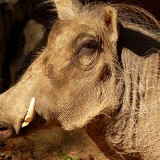CLASSIFICATION
Order: Cetartiodactyla
Family: Hippopotamidae
Genus: Choeropsis
Species: liberiensis
IDENTIFICATION
The Pygmy Hippopotamus is a smaller version of the closely related, and more well-known, Common Hippopotamus (Hippopotamus amphibius). The Pygmy Hippopotamus is only half as tall as the Common Hippopotamus and weighs less than 1/4 of its much larger cousin. While both are similar in some respects, such as a broad snout, a large mouth, a short, barrel-shaped body and short stocky legs, there are noticeable physical differences between the two species. The Pygmy Hippo’s head is more rounded and the eyes are set on the side of the head rather than the front. Its smooth, almost hairless skin is greenish black above, fading to grey on the sides and greyish-white below. It has well separated toes with sharp nails, unlike the Common Hippopotamus which has webbed feet. The Pygmy Hippopotamus has incisors and canines that are tusk-like and grow rapidly. The ears and large and rounded nostrils can be closed when the animal is under water.
SIZE
Length: 4.5 to 6.0 ft.
Height (at shoulder): 2.5 to 3.0 ft.
Weight: 400 to 600 lbs.
RANGE
The Pygmy Hippopotamus is found in western Africa, mainly in Liberia, but also in Sierra Leone, Guinea, and Côte d’Ivoire. A vital area for the Pygmy Hippo’s protection is Sapo National Park in eastern Liberia.
HABITAT
Swamps, wallows or rivers and sometimes in hollows under the banks of streams. It favors heavily forested regions, but it is dependent on water and usually remains close to streams. Within the forest, it follows well defined trails or tunnel-like paths through swamp vegetation.
REPRODUCTION
Pygmy Hippos are known to breed throughout the year in captivity. Sexual maturity is attained at 4-5 years of age. Gestation period lasts for 184 – 204 days and typically a single young is born weighing about 10 to 14 lbs. Weaning occurs at 6 – 8 months. The lifespan of the species in the wild is not known, although one managed individual was reported to live for more than 43 years.
DIET
The species is exclusively vegetarian, feeding on leaves and roots of forest plants (including semi-aquatic plants and forest herbs) as well as on fallen fruit.
BEHAVIOR
The Pygmy Hippo is rarely seen because of its secretive, nocturnal habits. The Pygmy Hippopotamus is much less social than the larger Common Hippotamus, and is usually found either solitary or in pairs.
POINTS OF INTEREST
- The name hippopotamus derives from the Greek for ‘river horse’
- Hippopotami (plural) were formerly believed to be most closely related to pigs or peccaries. However, recent genetic studies have revealed that their closest living relatives are in fact whales.
- The Pygmy Hippo’s range does not overlap with that of the Common Hippopotamus.
- A subspecies existed in Nigeria, but this is now believed to be extinct as there have been no sightings for decades.
- Both species secrete a protective mucous through their skin to keep it from drying out in the hot rays of the equatorial sun.
STATUS
Habitat loss and poaching for bushmeat are the greatest threats to the Pygmy Hippopotamus.
IUCN Redlist – Endangered
CITES – Appendix II
REFERENCES
http://www.iucnredlist.org/details/summary/10032/0
http://pygmyhippofoundation.org/pygmy-hippos/
http://www.edgeofexistence.org/mammals/species_info.php?id=21
http://www.arkive.org/pygmy-hippopotamus/choeropsis-liberiensis/







